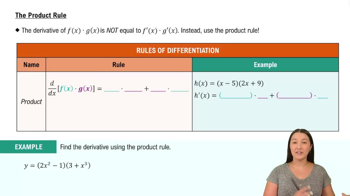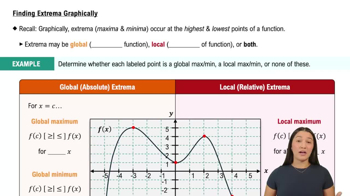Table of contents
- 0. Functions7h 52m
- Introduction to Functions16m
- Piecewise Functions10m
- Properties of Functions9m
- Common Functions1h 8m
- Transformations5m
- Combining Functions27m
- Exponent rules32m
- Exponential Functions28m
- Logarithmic Functions24m
- Properties of Logarithms34m
- Exponential & Logarithmic Equations35m
- Introduction to Trigonometric Functions38m
- Graphs of Trigonometric Functions44m
- Trigonometric Identities47m
- Inverse Trigonometric Functions48m
- 1. Limits and Continuity2h 2m
- 2. Intro to Derivatives1h 33m
- 3. Techniques of Differentiation3h 18m
- 4. Applications of Derivatives2h 38m
- 5. Graphical Applications of Derivatives6h 2m
- 6. Derivatives of Inverse, Exponential, & Logarithmic Functions2h 37m
- 7. Antiderivatives & Indefinite Integrals1h 26m
- 8. Definite Integrals4h 44m
- 9. Graphical Applications of Integrals2h 27m
- 10. Physics Applications of Integrals 2h 22m
5. Graphical Applications of Derivatives
Intro to Extrema
Problem 4.1.89b
Textbook Question
Values of related functions Suppose f is differentiable on (-∞,∞) and assume it has a local extreme value at the point x = 2, where f(2) = 0. Let g(x) = xf(x) + 1 and let h(x) = xf(x) + x +1, for all values of x.
b. Does either g or h have a local extreme value at x = 2? Explain.
 Verified step by step guidance
Verified step by step guidance1
To determine if g(x) or h(x) has a local extreme value at x = 2, we need to find their derivatives and evaluate them at x = 2.
First, find the derivative of g(x) = x * f(x) + 1. Use the product rule for differentiation: if u(x) = x and v(x) = f(x), then the derivative g'(x) = u'(x)v(x) + u(x)v'(x).
Calculate g'(x): g'(x) = 1 * f(x) + x * f'(x) = f(x) + x * f'(x).
Evaluate g'(x) at x = 2: g'(2) = f(2) + 2 * f'(2). Since f(2) = 0 and f has a local extreme at x = 2, f'(2) = 0. Thus, g'(2) = 0.
Now, find the derivative of h(x) = x * f(x) + x + 1. Differentiate h(x) using the sum and product rules: h'(x) = f(x) + x * f'(x) + 1. Evaluate h'(x) at x = 2: h'(2) = f(2) + 2 * f'(2) + 1. Since f(2) = 0 and f'(2) = 0, h'(2) = 1, indicating h does not have a local extreme at x = 2.
 Verified video answer for a similar problem:
Verified video answer for a similar problem:This video solution was recommended by our tutors as helpful for the problem above
Video duration:
5mPlay a video:
Was this helpful?
Key Concepts
Here are the essential concepts you must grasp in order to answer the question correctly.
Local Extreme Values
A local extreme value of a function occurs at a point where the function reaches a maximum or minimum relative to its immediate surroundings. For a function to have a local extreme value at a point, the derivative at that point must be zero, indicating a horizontal tangent. In this case, since f has a local extreme at x = 2, we know that f'(2) = 0.
Recommended video:

Average Value of a Function
Differentiability and Derivatives
A function is differentiable at a point if it has a defined derivative there, which means it is smooth and has no sharp corners or discontinuities. The derivative provides information about the function's rate of change and is crucial for determining local extreme values. Since f is differentiable everywhere, we can analyze the derivatives of g and h to assess their behavior at x = 2.
Recommended video:

Finding Differentials
Product Rule in Differentiation
The product rule is a formula used to find the derivative of the product of two functions. If u(x) and v(x) are functions, the derivative of their product is given by u'v + uv'. This rule is essential for differentiating g(x) = xf(x) and h(x) = xf(x) + x + 1, as both functions involve the product of x and f(x), allowing us to determine if they have local extreme values at x = 2.
Recommended video:

The Product Rule

 5:58m
5:58mWatch next
Master Finding Extrema Graphically with a bite sized video explanation from Callie
Start learning





